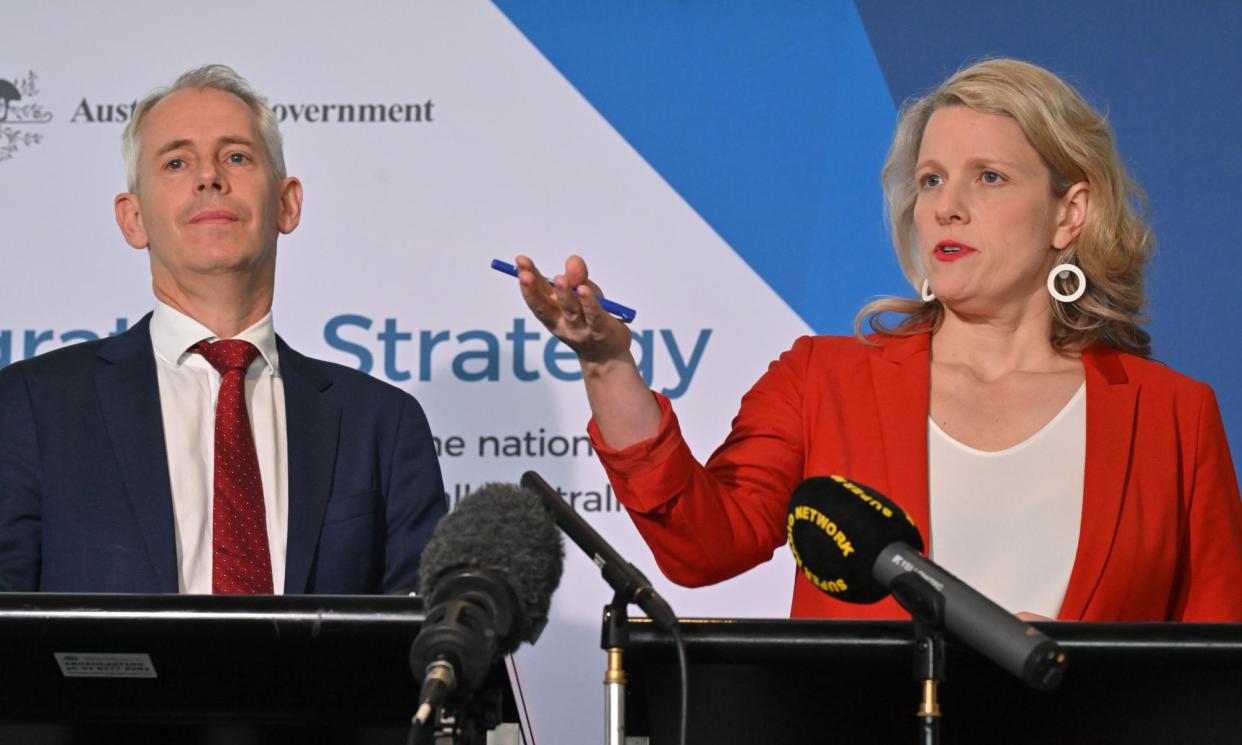Clare O’Neil won’t rule out international student cap as part of visa crackdown

The home affairs minister, Clare O’Neil, has not ruled out a cap on international students but declared she is “confident” new measures have caught the “problem” of student visas being used as a back door into Australia in time to reduce net overseas migration.
On Monday O’Neil insisted the government does not have a “target” for net overseas migration because some elements, such as people leaving Australia, are not within its control but promised it will show “vigilance” to achieve a reduction. It is forecasting nearly 185,000 fewer people over five years as a result of its policies.
Related: Labor targets student and some worker visas in overhaul of Australia’s temporary migration program
The government’s new migration strategy won plaudits from unions and business, although the former is pushing for more commitments on training Australians and the latter wants tradies included in the new highly skilled visa pathway.
Under changes the government says are aimed at reducing exploitation and improving the work prospects of international students, people entering Australia on a student visa will face tougher minimum English-language requirements in line with those for skilled visa applicants.
O’Neil told reporters on Monday the government would also shorten graduate visas that allow students to stay up to eight years – “the longest in the world” – to prevent them becoming “permanently temporary”.
She said the number of international students in Australia had reduced from a projected 850,000 pre-pandemic to 650,000.
“We expect to see that sector continue to grow, but we don’t want it to grow as fast as it has been growing in the past few years,” she said.
“If we do not succeed in that, of course, there are other things that we can do,” she said, when asked about a possible cap on international student numbers.
But O’Neil added she was confident the government had “caught this problem in time” and the new measures would help “bring net oversees migration back to normal in a very short time frame”.
The government forecasts net overseas migration will fall from 510,000 in 2022-23 to 235,000 in 2026-27, with a total reduction of 185,000 fewer people over five years as a result of its policies. O’Neil insisted this was “not a target, it’s an estimate”.
The former deputy secretary of the immigration department, Abul Rizvi, told Guardian Australia the government “wants to have it both ways, so that if it meets the target in can say ‘Oh, weren’t we good?’ but if it misses it can say, ‘It’s just an estimate.’”
Labor is wedged between the Greens arguing it is in a “race to the bottom” over fears migration is adding stress to the housing market and the Coalition which argued it had not done enough to contain an explosion of arrivals after Covid border closures were lifted.
Rizvi praised the focus on net overseas migration as “crucial” to issues including the impact on the economy, congestion, housing and government services.
Rizvi said a cap on international student numbers would “create chaos” and be “indiscriminate”, harming good students as well as “ordinary ones”, and similarly disapproved of calls from the Grattan Institute to increase fees.
He said using “subjective criteria” such as the new genuine student test may not be “sustainable” and he proposed instead using international test scores to raise entry standards for students.
Universities Australia welcomed both integrity measures to “protect students from unscrupulous operators seeking to exploit them for personal gain” and steps “to simplify graduate visas”.
The Australian Council of Trade Unions and Business Council of Australia approved the changes to skill pathways: a high-skilled pathway for those earning more than $135,000, a “core” pathway for temporary shortages, and an essential worker pathway, which is still to be designed.
But the Australian Chamber of Commerce and Industry chief executive, Andrew McKellar, said it was “unfortunate that the specialist skills pathway excludes tradespeople”.
O’Neil said the government hadn’t made it “harder” for tradies, “we’re just not making it easier”.
“Our government feels strongly that for a sector like trades, you should have to prove that there is a skills shortage before you start to recruit overseas,” she said.
Michael Wright, the national secretary of the Electrical Trades Union, told Guardian Australia he was “broadly supportive” of the reforms. But he said he would continue to push for training Australians and employing apprentices to be a pre-requisite for labour migration agreements.
Wright said that agreements such as one offered to the Energy Connect transmission project, which allows it to employ 400 migrant workers but does not commit it to employ apprentices or trainees as “intolerable”.
“Electricians have been in temporary shortage for more than 30 years, so migration needs to go hand in hand with vocational education,” he said.
The shadow immigration spokesperson, Dan Tehan, said despite Labor’s claims to have reduced net overseas migration, it appeared to be predicting 1.6 million over five years, up from 1.5 million in the budget.
Despite the Coalition welcoming return of international students in 2022, on Monday Tehan criticised the government for not going far enough. He argued a prediction of less migration in “four to five year’s time” showed the government was “not serious about getting migration under control”.
The Coalition was “not ruling caps [on international students] in or out”.
The Greens immigration spokesperson, Nick McKim, said Labor “mindlessly blaming migration for Australia’s housing crisis just shows that there is very little difference between the major parties”.


